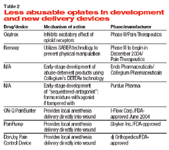GAIN WITHOUT PAIN New drugs in development aim to relieve pain without addiction
The recently published results from the 2003 National Survey on Drug Use and Health show decreased use of marijuana among 12- to 17-year-olds, but the bad news is that 31.2% of Americans age 12 and older have abused prescription painkillers at least once in their lifetime. This number represents an increase of 5% in only one year, according to the Substance Abuse and Mental Health Services Administration (SAMHSA). What's worse is a 15% increase in use by young adults (ages 18-25) in lifetime as well as current use. These statistics have left many pain experts, government agencies, advocacy groups, and pharmaceutical companies searching for answers.
The recently published results from the 2003 National Survey on Drug Use and Health show decreased use of marijuana among 12- to 17-year-olds, but the bad news is that 31.2% of Americans age 12 and older have abused prescription painkillers at least once in their lifetime. This number represents an increase of 5% in only one year, according to the Substance Abuse and Mental Health Services Administration (SAMHSA). What's worse is a 15% increase in use by young adults (ages 18-25) in lifetime as well as current use. These statistics have left many pain experts, government agencies, advocacy groups, and pharmaceutical companies searching for answers
In an effort to combat at least part of the problem, drug manufacturers are hoping to reformulate traditional narcotics and develop new devices to lessen the abuse potential.
What's the attraction? "These are highly addictive narcotics that the body perceives exactly as if the person is taking heroin," Charles Curie, administrator of SAMHSA, said recently of painkillers diverted from their legitimate use. The appeal comes from crushing, chewing, or smoking the drug, giving the user an immediate high.

Despite the skyrocketing rates of abuse, pain experts remind us that patients suffering from serious pain require and deserve an effective painkiller. "There are many effective ways to prevent abuse of opioids by legitimate users," Brushwood said. Limiting therapy is risky because they may be denied necessary medication, he added.

Pain Therapeutics (South San Francisco, Calif.) is attempting this feat with Oxytrex, an ultra-low-dose naltrexone, a product the company believes could be an effective substitute for oxycodone. The drug preferentially inhibits the excitatory effect of opioid receptors thought to counteract analgesia and cause tolerance, but it does not interfere with the inhibitory pathway associated with pain relief.
The opioid response becomes more excitatory as the analgesics are used chronically, said Remi Barbier, president and CEO of Pain Therapeutics, at the 11th Annual NewsMakers in the Biotech Industry meeting in September. "We believe this leads to many of the long-term ill effects of opioid use, such as physical dependence and tolerance," he said.
The drug is being tested in two large phase III studies. The first was initiated in June 2003 and is designed to assess efficacy and safety, compared with placebo and oxycodone, in over 700 patients with severe lower back pain. A second safety and efficacy trial began in March of this year in 700 patients with osteoarthritic pain. Barbier expects to have data from these studies in the first and second quarters of 2005, respectively.
A second drug, Remoxy, from the same company, is a long-acting oxycodone capsule that incorporates abuse-deterrent properties. "We believe it's significantly less abusable than the existing version of oxycodone," Barbier said. Remoxy has a timed-release mechanism that is not destroyed by physical manipulation, such as crushing, he added. Utilizing Durect Corp.'s patented SABER technology, Remoxy's oxycodone is contained in sucrose acetate isobutyrate, a high-viscosity, biodegradable liquid matrix that is formed into an oral gel-cap.
Targeted Drug Combination Reveals New Activity in Brain Tumors
December 28th 2021A combination of two targeted cancer drugs showed unprecedented, “clinically meaningful” activity in patients with highly malignant brain tumors that carried a rare genetic mutation, according to a clinical trial report by investigators from Dana-Farber Cancer Institute.